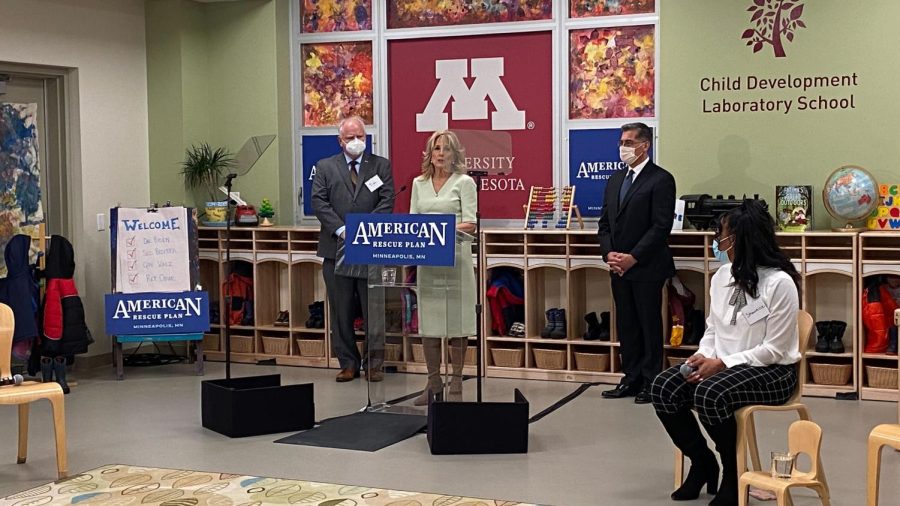First Lady Jill Biden traveled to the University of Minnesota’s Child Development Laboratory School Wednesday to showcase the funding childcare and early education institutions received from the American Rescue Plan.
The roundtable event included Biden, United States Secretary of Health and Human Services Xavier Becerra, Gov. Tim Walz, Lt. Gov. Peggy Flanagan, Rep. Ilhan Omar and childcare leaders from across the state. Biden started the event by highlighting the plight of working mothers during the pandemic, saying that COVID-19 has provided unique challenges to parents of young children.
“She needed that job, but she needed to take care of her children more,” Biden said of working moms at the event. “There was no choice, so she walked away from the labor force.”
The event was held in a classroom at the Child Development Laboratory School in Southeast Como. Signs saying “American Rescue Plan,” as well as the “ARP” abbreviation, adorned many open spaces in the room, including a children’s chalkboard. Biden said she chose the University because of Walz’s continued investment in the state’s early education program.
Attendees said funding from the American Rescue Plan helped them by giving their children the necessary education tools before kindergarten. Parents also talked about the need to pass President Joe Biden’s Build Back Better Act, which is currently stalled in the United States Senate.
Dr. Elizabeth Davis, who participated in the event, said Build Back Better would provide early education for low-income children and would provide different types of funding to help families enroll their kids in these services.
“The Build Back Better Act is a historic investment in early childhood, education and childcare. It is only going to get us part of the way there because it’s set to end in six years,” Davis said at the event.
Minnesota received $537 million in child care funding from the American Rescue Plan. Walz’s proposed budget for the upcoming legislative session includes nearly $1.8 billion for mixed delivery child care and early education, particularly aimed at low-income families.
“When we talk about these numbers, they matter,” Walz said at the event. “This [budget] is a critical document. It’s also a moral reflection to really care about. These aren’t dollars, they’re children, here to take care of families.”
At the discussion was Shawnice Walls, a single parent with two kids in daycare. She talked about going to school, working, juggling parenting alone, as well as closing childcare centers.
“I’ve mostly put my kids first. The sacrifices, they’re hard to make,” Walls said at the event. “But I have to put them first. I had to put everything on hold.”
Davis said stories like Walls are representative of what is happening across the country.
“The specifics — they vary, but in general, families have struggled with childcare closing, even if it’s closing temporarily,” Davis said. “Suddenly, if you have to go to work or if you’re going if you’re home, it’s just much harder to do that work.”



















